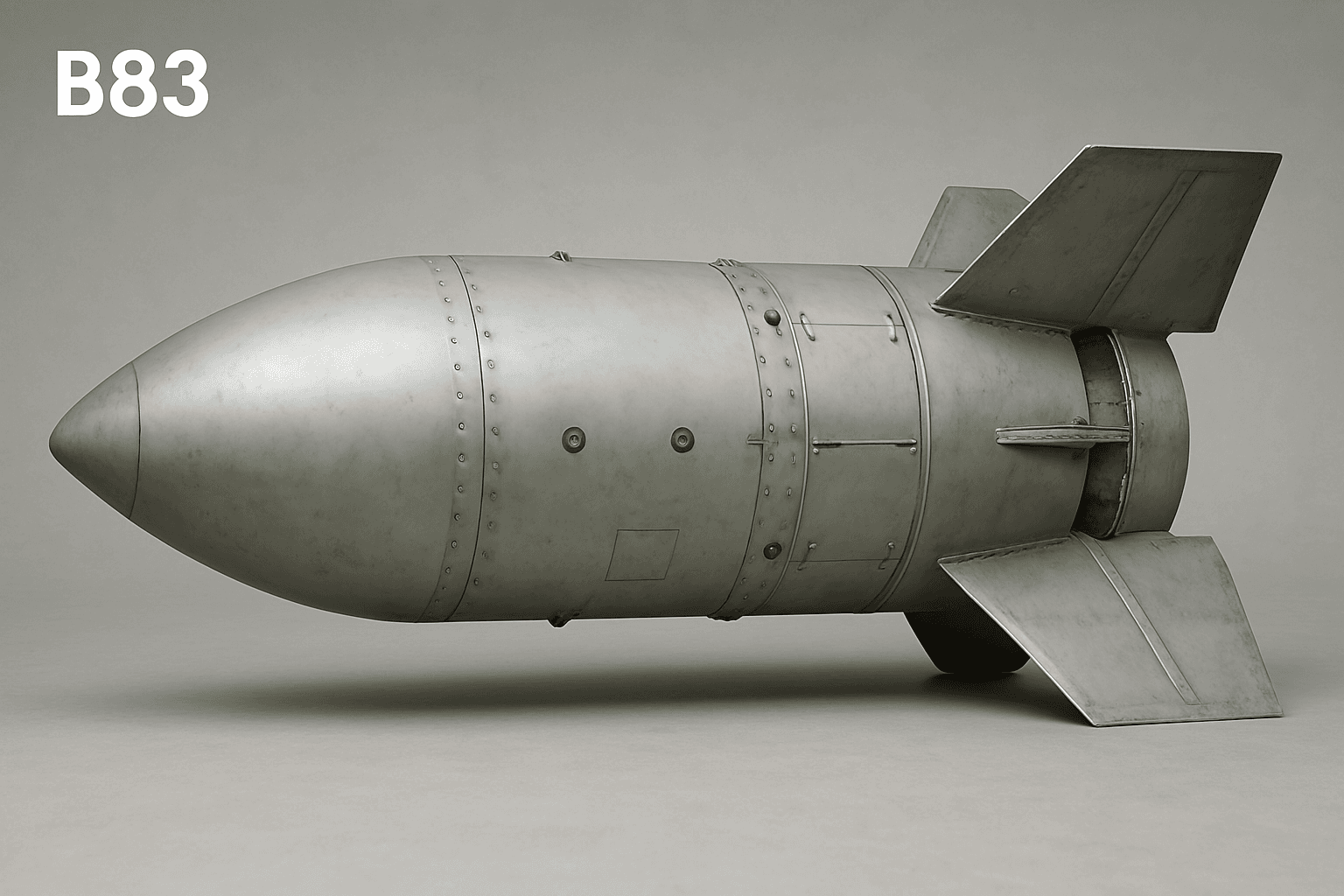
B83 Nuclear Bomb
America's Last Megaton-Class Warhead
Table of Contents
Historical Context of Development
The B83 is a high-yield thermonuclear gravity bomb developed by the United States in the late 1970s and first entering service in 1983. It was conceived at the end of the Cold War era to replace several earlier free-fall nuclear bombs (such as the B28, B43, and the huge B53), providing the U.S. with a "city-buster" weapon of immense power.
Designed at Lawrence Livermore National Laboratory, the B83 was the first U.S. nuclear weapon engineered with enhanced safety features from the start, including insensitive high explosives to reduce accidental detonation risks. Over 600 B83 bombs were produced during the 1980s, and it became the highest-yield weapon in the U.S. nuclear arsenal after the retirement of the older B53 in 2011.
Cold War Context: By the 2010s, military planners viewed the B83 as a Cold War "relic" – its extreme explosive power was seen as less flexible and less useful against modern targets.
Plans were announced in the 2020s to retire the B83 in favor of newer, lower-yield guided bombs, marking the end of the era of U.S. megaton-class weapons.
Design and Technical Specifications
The B83 is a two-stage thermonuclear bomb with a variable yield. In design, it shares lineage with the earlier canceled B77 program and the smaller B61 bomb, but the B83 is significantly larger and more powerful. It can be deployed in various modes (airburst, groundburst, or even laydown delivery by parachute) to optimize its effects on different target types.
Key Specifications
Physical Dimensions
- Weight: ~2,400 pounds (≈1,100 kg)
- Length: ~12 feet (≈3.7 m)
- Diameter: ~18 inches (46 cm)
Performance
- Maximum Yield: Up to 1.2 megatons
- Yield Type: Variable (dial-a-yield capability)
- Delivery: Air-dropped free-fall bomb
Despite its size, the B83 features modern safety mechanisms such as advanced Permissive Action Links and a command-disable system to prevent unauthorized use. It was built to be carried at supersonic speeds and can be released at either high altitude or very low altitude, thanks to a 14-meter ribbon parachute that slows its descent.
Notable Tests and Usage
The B83 was never used in combat, but it underwent proof testing during development. A modified B83 device was test-fired underground in December 1984 during the Grenadier Tierra nuclear test, albeit at a much reduced yield of 80 kilotons in compliance with test ban limits. This test validated the bomb's design and performance.
Service Record: In service, the B83 has been carried by U.S. strategic bombers as a part of the nuclear deterrent. It is one of the few remaining gravity bombs in the U.S. arsenal with megaton-range yield – essentially reserved for the most hardened or sprawling targets.
No B83 has ever been detonated in conflict (and hopefully never will be). By the 21st century, with strategic emphasis shifting to precision and lower-yield options, the B83's role has been limited and largely symbolic. It remained in the stockpile primarily as a weapon of last resort capable of devastating vast areas.
Detonation Power and Blast Range in Relatable Terms
At maximum yield, the B83 packs an almost unfathomable punch. 1.2 megatons is equivalent to 1,200,000 tons of TNT. In practical terms, that is about 80 times the explosive energy of the atomic bomb that destroyed Hiroshima in 1945.
Devastating Scale: A single B83, if detonated at optimum altitude, could flatten an entire metropolitan area. The fireball from a 1.2 MT explosion would stretch over a mile in diameter and shine hotter than the sun.
The blast wave would generate pressures capable of demolishing reinforced concrete buildings many miles from ground zero. Studies by the U.S. government found that the fallout from a surface burst in the megaton range would be catastrophic – potentially lethal over thousands of square kilometers downwind.
Comparative Destruction Analysis
For instance, one analyst noted that a one-megaton bomb dropped on a hardened underground facility could kill up to 3 million people from blast, fire, and radiation in surrounding populated areas.
In short, the B83 could turn a large city into an uninhabitable wasteland in seconds – a grim testament to the raw power of Cold War-era nuclear weapons.
Role in Military Strategy and Legacy
Strategically, the B83 was meant to serve as the ultimate deterrent. During the waning years of the Cold War, it gave the U.S. the ability to threaten the destruction of hardened command bunkers, deep underground facilities, or entire urban-industrial regions of an adversary.
However, its enormous yield also limited its practical utility. Military planners grew to favor weapons that could be precisely targeted to avoid unnecessary civilian casualties and widespread fallout. In fact, U.S. Strategic Command leaders cited the B83's high yield as a "shortcoming", noting it was less flexible in a world where smaller strikes might be preferred.
Modern Transition: By the 2010s, the B83 was increasingly seen as a Cold War artifact. The U.S. government has indicated that once the upgraded B61-12 (and a planned B61-13 variant) are fully deployed, the B83 will be retired.
The legacy of the B83 is therefore twofold: on one hand, it's a powerful reminder of the peak of nuclear arms race capabilities – the largest yield bomb in the U.S. arsenal for decades. On the other hand, its retirement highlights the shift toward more usable (lower-yield, accurate) nuclear weapons and a hope that such globe-threatening mega-bombs will never be needed again.
The B83 will be remembered as the United States' final megaton-class nuclear bomb, a sobering symbol of the destructive extremes of the Cold War and a relic whose looming presence ultimately helped deter superpower conflict without ever being used.
Related Articles
Experience Nuclear Physics Simulation
Understand the devastating power of weapons like the B83 through our interactive nuclear explosion simulator.
Launch Nuclear Simulator